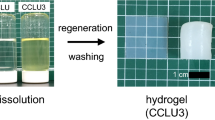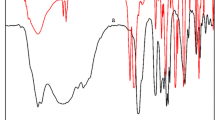Abstract
A new gelatin-coupled cellulose (GCC) microgel system was successfully prepared in NaOH/urea aqueous solution with epichlorohydrin (ECH) as a coupling agent via dialysis and self-dispersion pathway. The structure and property of the microgel and its membrane were characterized by elemental analysis, dynamic light scattering (DLS), Fourier transform infrared (FTIR) spectra, gel permeation chromatography (GPC), scanning electron microscopy (SEM), atomic force microscopy (AFM), X-ray diffraction (XRD) and thermogravimetric analysis (TGA). It was concluded that successful coupling interactions occurred between cellulose and gelatin during the fabrication process, and the weight-average molecular weight of GCC microgel was up to 636.60 kDa with polydispersity index (PDI) of 1.015 approximately. The crystalline structure of the modified cellulose was destroyed, leading to GCC product self-dispersed in water in the absence of NaOH and urea. The GCC microgels had whisker-like structure, and their Z-average particle sizes were approximately 86.1 nm–150.2 nm and decreased with the increases of the gelatin content (WGel). In comparison with the water contact angle, swelling behavior and thermostability of the existing water-soluble cellulose derivative, the microgel membranes exhibited better water resistance and thermal resistance properties.
Graphical abstract








Similar content being viewed by others
References
Banerjee I, Mishra D, Maiti T (2009) PLGA microspheres incorporated gelatin scaffold: microspheres modulate scaffold properties. Int J Biomater 2009:1–9
Cai J, Zhang L (2005) Rapid dissolution of cellulose in LiOH/Urea and NaOH/Urea aqueous solutions. Macromol Biosci 5:539–548
Cai J, Liu Y, Zhang L (2006) Dilute solution properties of cellulose in LiOH/urea aqueous system. J Polym Sci Part B Polym Phys 44:3093–3101
Ciolacu D, Rudaz C, Vasilescu M, Budtova T (2016) Physically and chemically cross-linked cellulose cryogels: structure, properties and application for controlled release. Carbohyd Polym 151:392–400
Ding C, Zhang M, Li G (2015) Preparation and characterization of collagen/hydroxypropyl methylcellulose (HPMC) blend film. Carbohyd Polym 119:194–201
Duan H, Shao Z, Zhao M, Zhou Z (2016) Preparation and properties of environmental-friendly coatings based on carboxymethyl cellulose nitrate ester & modified alkyd. Carbohyd Polym 137:92–99
Eriksson J, Malmsten M, Tiberg F, Callisen T, Damhus T (2005) Enzymatic degradation of model cellulose films. J Colloid Interface Sci 284(1):99–106
Esteghlal S, Niakosari M, Hosseini S, Mesbahi G, Yousefi G (2016) Gelatin-hydroxypropyl methylcellulose water-in-water emulsions as a new bio-based packaging material. Int J Biol Macromol 86:242–249
Farzamfar S, Naseri N, Vaez A, Esmaeilpour F, Ehterami A, Sahrapeyma H (2017) Neural tissue regeneration by a gabapentin-loaded cellulose acetate/gelatin wet-electrospun scaffold. Cellulose 25(2):1229–1238
French A (2014) Idealized powder diffraction patterns for cellulose polymorphs. Cellulose 21:885–896
Ge W, Guo Y, Zhong H (2015) Synthesis, characterization and micellar behaviors of hydroxyethyl cellulose-graft-poly(lactide/e-caprolactone/p-dioxanone). Cellulose 22(4):2365–2374
Geng H (2018) A one-step approach to make cellulose-based hydrogels of various transparency and swelling degrees. Carbohyd Polym 186:208–216
Guo Y, Wang X, Shu X, Shen Z, Sun R (2012) Self-assembly and paclitaxel loading capacity of cellulose-graft-poly(lactide) nanomicelles. J Agric Food Chem 60(15):3900–3908
Guo Y, Wang X, Shen Z, Shu X, Sun R (2013) Preparation of cellulose-graft-poly(ε-caprolactone) nanomicelles by homogeneous ROP in ionic liquid. Carbohyd Polym 92(1):77–83
Hu H, You J, Gan W, Zhou J, Zhang L (2015) Synthesis of allyl cellulose in NaOH/urea aqueous solutions and its thiol-ene click reactions. Polym Chem 6:3543–3548
Ifuku S, Kadla JF (2009) Preparation of a thermosensitive highly regioselective cellulose/N-isopropylacrylamide copolymer through atom transfer radical polymerization. Biomacromolecules 9(11):3308–3313
Jiang F, Hsieh Y (2016) Self-assembling of TEMPO oxidized cellulose nanofibrils as affected by protonation of surface carboxyls and drying methods. ACS Sustain Chem Eng 4:1041–1049
Karlsson K, Schuster E, Stading M, Rigdahl M (2015) Foaming behavior of water-soluble cellulose derivatives: hydroxypropyl methylcellulose and ethyl hydroxyethyl cellulose. Cellulose 22(4):2651–2664
Kirdponpattara S, Phisalaphong M, Kongruang S (2017) Gelatin-bacterial cellulose composite sponges thermally cross-linked with glucose for tissue engineering applications. Carbohyd Polym 177:361–368
Klemm D, Heublein B, Fink H, Bohn A (2005) Cellulose: faszinierendes biopolymer und nachhaltiger rohstoff. Angew Chem 117(22):3422–3458
Liu Y, Jin X, Zhang X, Han M, Ji S (2015) Self-assembly and chiroptical property of poly(N-acryloyl-L-amino acid) grafted celluloses synthesized by RAFT polymerization. Carbohyd Polym 117:312–318
Lu Y, Yuan W (2018) Superhydrophobic three-dimensional porous ethyl cellulose absorbent with micro/nano-scale hierarchical structures for highly efficient removal of oily contaminants from water. Carbohyd Polym 191:86–94
Ma S, Song G, Feng N (2012) Preparation and characterization of self-emulsified waterborne nitrocellulose. Carbohyd Polym 89:36–40
Ma Y, Zhou G, Ding J, Li S, Wang G (2018) Preparation and characterization of an agglomeration-cementing agent for dust suppression in open pit coal Mining. Cellulose 25:4011–4029
Maciejewski B, Weitschies W, Schneider F, Sznitowska M (2017) Gastroresistant gelatin films prepared by addition of cellulose acetate phthalate. Pharmazie 72(6):324–328
Navarra M, Bosco C, Moreno J, Vitucci F, Paolone A, Panero S (2015) Synthesis and characterization of cellulose-based hydrogels to be used as gel electrolytes. Membranes 5(4):5810–5823
Ooi S, Ahmad I, Amin M (2015) Cellulose nanocrystals extracted from rice husks as a reinforcing material in gelatin hydrogels for use in controlled drug delivery systems. Ind Crops Prod 93:227–234
Pei Y, Yang J, Liu P, Xu M, Zhang X, Zhang L (2013) Fabrication, properties and bioapplications of cellulose/collagen hydrolysate composite films. Carbohyd Polym 92:1752–1760
Pei Y, Ye D, Zhao Q, Wang X, Zhang C (2015) Effectively promoting wound healing with cellulose/gelatin sponges constructed directly from a cellulose solution. J Mater Chem B 3:7518–7528
Qi H, Liebert T, Meister F, Heinze T (2009) Homogenous carboxymethylation of cellulose in the NaOH/urea aqueous solution. React Funct Polym 69:779–784
Qin X, Lu A, Zhang L (2013) Gelation behavior of cellulose in NaOH/urea aqueous system via cross-linking. Cellulose 20:1669–1677
Qiu X, Tao S, Ren X, Hu S (2012) Modified cellulose films with controlled permeatability and biodegradability by crosslinking with toluene diisocyanate under homogeneous conditions. Carbohyd Polym 88:1272–1280
Quero F, Coveney A, Lewandowska A, Richardson R, Calderón P, Lee K, Eichhorn S, Alam M, Enrione J (2015) Stress transfer quantification in gelatin-matrix natural composites with tunable optical properties. Biomacromolecules 16:1784–1793
Quero F, Padilla C, Campos V, Luengo J, Caballero L, Melo F, Li Q, Eichhorn S, Enrione J (2018) Stress transfer and matrix-cohesive fracture mechanism in microfibrillated cellulose-gelatin nanocomposite films. Carbohyd Polym 195:89–98
Song Y, Sun Y, Zhang X, Zhou J, Zhang L (2008) Homogeneous quaternization of cellulose in NaOH/Urea aqueous solutions as gene carriers. Biomacromolecules 9:2259–2264
Su X, Zhao Q, Zhang D, Dong W (2015) Synthesis and membrane performance characterization of self-emulsified waterborne nitrocellulose dispersion modified with castor oil. Appl Surf Sci 356:610–614
Su X, Zhang Y, Zhao D, Chen Z (2017) Synthesis and characterization of carboxylate waterborne cellulose emulsion based on cellulose acetate. Cellulose 24(5):1–9
Sui X, Yuan J, Zhou M, Zhang J, Yang H (2008) Synthesis of cellulose-graft-poly(N,N-dimethylamino-2-ethyl methacrylate) copolymers via homogeneous ATRP and their aggregates in aqueous media. Biomacromolecules 9(10):2615–2620
Sun N, Wang T, Yan X (2017) Self-assembled supermolecular hydrogel based on hydroxyethyl cellulose: formation, in vitro release and bacteriostasis application. Carbohyd Polym 172:49–59
Suzuki T, Kono K, Shimomura K, Minami H (2014) Preparation of cellulose particles using an ionic liquid. J Colloid Interface Sci 418:126–131
Theerawitayaart W, Prodpran T, Benjakul S, Sookchoo P (2019) Properties of films from fish gelatin prepared by molecular modification and direct addition of oxidized linoleic acid. Food Hydrocolloids 88:291–300
Tristram CJ, Mason JM, Williams DB, Hinkley SF (2015) Doubly renewable cellulose polymer for water-based coatings. ChemSusChem 8(1):63–66
Wang B, Lv X, Chen S, Li Z, Yao J (2017) Bacterial cellulose/gelatin scaffold loaded with VEGF-silk fibroin nanoparticles for improving angiogenesis in tissue regeneration. Cellulose 24(11):5013–5024
Xia G, Wan J, Zhang J, Zhang X, Xu L, Wu J (2016) Cellulose-based films prepared directly from waste newspapers via an ionic liquid. Carbohyd Polym 151:223–229
Xu F, Zhu Y, Liu F, Nie J, Ma J (2010) Comb-shaped conjugates comprising hydroxypropyl cellulose backbones and low-molecular-weight poly(N-isopropylacryamide) side chains for smart hydrogels: synthesis, characterization, and biomedical applications. Bioconjug Chem 21(3):456–464
Yang Q, Lv A, Qi H, Sun Y, Zhang X, Zhang L (2009) Properties and bioapplications of blended cellulose and corn protein films. Macromol Biosci 9:849–856
Yang X, Liu G, Peng L, Guo J, Tao L (2017) Highly efficient self-healable and dual responsive cellulose-based hydrogels for controlled release and 3D cell culture. Adv Func Mater 27(40):1–10
You J, Zhao L, Wang G, Zhou H, Zhou J, Zhang L (2014) Quaternized cellulose-supported gold nanoparticles as capillary coatings to enhance protein separation by capillary electrophoresis. J Chromatogr A 1343:160–166
Yuan Z, Zhang J, Jiang A, Lv W, Wang Y, Geng H (2015) Fabrication of cellulose self-assemblies and high-strength ordered cellulose films. Carbohyd Polym 117:414–421
Zhang X, Weeks BL (2014) Preparation of sub-micron nitrocellulose particles for improved combustion behavior. J Hazard Mater 268:224–228
Zhang X, Liu X, Zheng W, Zhu J (2012) Regenerated cellulose/graphene nanocomposite films prepared in DMAC/LiCl solution. Carbohyd Polym 88:26–30
Zhang D, Zhang N, Song P, Hao J, Wan Y (2018a) Functionalized cellulose beads with three dimensional porous structure for rapid adsorption of active constituents from Pyrola incarnata. Carbohyd Polym 181:560–569
Zhang Y, Jiang Y, Han L, Wang B, Xu H (2018b) Biodegradable regenerated cellulose-dispersed composites with improved properties via a pickering emulsion process. Carbohyd Polym 179:86–92
Zhao Y, He M, Zhao L, Wang S, Li Y (2016) Epichlorohydrin-cross-linked hydroxyethyl cellulose/soy protein isolate composite films as biocompatible and biodegradable implants for tissue engineering. ACS Appl Mater Interfaces 8:2781–2795
Zhou J, Zhang L, Deng Q, Wu X (2004) Synthesis and characterization of cellulose derivatives prepared in NaOH/Urea aqueous solutions. J Polym Sci Part A Polym Chem 42:5911–5920
Zhou J, Qin Y, Liu S, Zhang L (2006) Homogenous synthesis of hydroxyethylcellulose in NaOH/Urea aqueous solution. Macromol Biosci 6:84–89
Zhou J, Xu Y, Wang X, Qin Y, Zhang L (2008) Microstructure and aggregation behavior of methylcelluloses prepared in NaOH/urea aqueous solutions. Carbohyd Polym 74:901–906
Acknowledgments
This work was supported by the Hongliang Research Fund (413118) and Doctor Research Fund of Shaanxi University of Science and Technology.
Author information
Authors and Affiliations
Corresponding author
Additional information
Publisher's Note
Springer Nature remains neutral with regard to jurisdictional claims in published maps and institutional affiliations.
Electronic supplementary material
Below is the link to the electronic supplementary material.
Rights and permissions
About this article
Cite this article
Yao, Y., Wang, H., Wang, R. et al. Fabrication and performance characterization of the membrane from self-dispersed gelatin-coupled cellulose microgels. Cellulose 26, 3255–3269 (2019). https://doi.org/10.1007/s10570-019-02263-w
Received:
Accepted:
Published:
Issue Date:
DOI: https://doi.org/10.1007/s10570-019-02263-w




